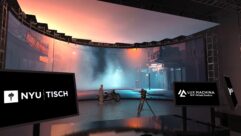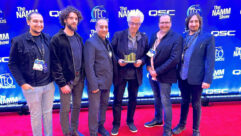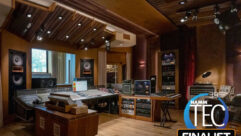

Writing on the Wall
A news item crossed my desk that would have slipped right by if it weren’t for my alert colleagues at Insight Media. The news: Syntax-Brillian Corp., a manufacturer and rebrander of HDTVs, is closing down its LCoS (liquid-crystal on silicon) fabs and technical facilities in Tempe, Ariz., to concentrate on flat-panel LCD HDTVs.
A news item crossed my desk that would have slipped right by if it weren’t for my alert colleagues at Insight Media. The news: Syntax-Brillian Corp., a manufacturer and rebrander of HDTVs, is closing down its LCoS (liquid-crystal on silicon) fabs and technical facilities in Tempe, Ariz., to concentrate on flat-panel LCD HDTVs.
Syntax-Brillian is an interesting marriage of two companies — Syntax Groups, which came out of nowhere a few years back to become an industry leader in sales of Olevia LCD HDTVs, and Brillian Corp., a spin-off of Three-Five Systems — which engaged in the research, development, and manufacturing of small LCoS panels for a variety of applications, including near-to-eye displays.
In 2002, a joint venture between Three-Five and RCA to produce rear-projection HDTVs (Scenium 5000) went terribly wrong. Panel yields were low, and RCA was never able to produce enough TVs to get a viable product to market. As a result, in 2003, Three-Five spun off its money-losing HDTV business into a new subsidiary — Brillian.
Most display industry analysts put Brillian on a “death watch” list at that time. Texas Instruments was successfully implanting DLP technology in consumer and professional rear-projection displays, while JVC and Sony were just getting their own LCoS efforts underway.
The insane price wars between the LCD and plasma camps had yet to materialize, but one only had to read the writing on the wall — flat-panel technology would only continue to get cheaper and larger, and rear-projection would get squeezed out at some point. The only question was, when?
Brillian struggled to get its large-screen LCoS RPTVs to market. It put on a good show at key industry events, such as CES and SID, with luxurious suites and schmoozing, but long-term prosperity always seemed to be “right around the corner.”
That is, until Brillian acquired Syntax Groups in ’05, a move that raised many eyebrows. In ’06, Syntax-Brillian opened a LCD and LCoS HDTVs assembly factory in Ontario, Calif., and in September ’06, the company finally achieved profitability.
CONNECTING THE DOTS
Enough history. What’s important is that Syntax-Brillian has decided to turn its back on rear-projection and concentrate on LCD technology. This finally closes the door on a line of products that never really got off the ground.
LCD flat panels are the low-hanging fruit these days, and everyone’s got ’em. It’s now possible to buy 52-inch LCD HDTVs for about $2,500, and 60-inch plasma HDTVs are available for about $3,000. That doesn’t leave much room for rear-projection technologies, especially models with price tags as expensive as Syntax-Brillian’s were.
DisplaySearch reported earlier this year that in 2006, microdisplay RPTV revenues declined worldwide by 7 percent from the previous year, a trend that has continued for several years now. The reason? Lower selling prices forced by the falling prices in LCD and plasma sets.
DisplaySearch claims the 862,000 microdisplay RPTV shipments in 2006 represent a 9 percent decline from 2005. And North America accounted for 89 percent of all RPTV revenue — the rest of the world prefers LCD and plasma technology.
There’s no indication that the price wars will let up. LCD manufacturers are building even bigger fabs these days, with Sharp announcing in June 2006 that it will invest $4.24 billion in a Gen-10 fab that can produce eight 57-inch or six 65-inch LCD panels from each piece of motherglass. In the LCD business, it’s all about economies of scale!
In the plasma world, Panasonic said earlier this year that it expects to be manufacturing 1.8 million plasma panels a year by 2009. Samsung has long jostled with Panasonic to maintain high levels of production, upwards of 100,000 units a month in all sizes. And Pioneer continues to hang in there, stating its plan to sell 160,000 plasma HDTVs in the United States by the end of its next fiscal year.
ZERO HOUR
For several years, display analysts have been pointing to 2008 as the year in which microdisplay RPTV products go away altogether. That’s not likely to happen, particularly with continued discounting by companies, such as Samsung, Sony, JVC, Mitsubishi, and Panasonic, for the 2007 holiday selling season.
But it could happen in 2009 or 2010. In the past year, we’ve seen Hitachi and Toshiba exit the RPTV business, choosing instead to concentrate on higher-margin LCD and plasma products. Toshiba was an early adopter of DLP RPTV technology and an aggressive discounter, while Hitachi moved from CRT light engines to 3LCD imaging before it threw in the towel.
The situation is declining precipitously enough that Texas Instruments is obviously concerned about long-term prospects for DLP sales, shifting its focus to public demonstrations of “laser DLP” HDTVs — products that retain a rear-projection design, but are so thin that they resemble LCD and plasma monitors. And of course, the laser light engine should last much longer than conventional short-arc lamps.
Even rear-projection stalwart Mitsubishi expanded its line of flat-panel LCDs this year, with a mix of eight LCD and nine DLP rear-projection. At Samsung’s line show in April, DLP RPTVs took a back seat to a bevy of LCD and plasma monitors.
What does any of this mean for the professional market? Just that the consumer electronics business drives the professional channel these days. Exactly how many rear-projection displays did you see at this year’s InfoComm show or CEDIA Expo? Not too many, I’ll bet.
One industry wag told me a few months ago that LCoS actually stands for “least chance of success.” That’s not completely true; several Chinese companies are still involved in LCoS R&D, and a few have actually brought products to market. And of course, Sony and JVC continue to manufacture rear projection engines, although both are adding more LCD HDTVs to their product lines with each year.
It’s clear that LCD and plasma are driving rear-projection technology out of all but the most specialized markets, such as those 70-inch home theater installations. The only question is, will the purge be complete in one, two, or three years? And when should we schedule the wake?
Contributing editor Pete Putman is president of ROAM Consulting in Doylestown, Pa. You can reach him at [email protected].










